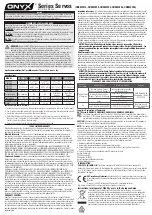
Logosol Absolute Positioning Servo Drive LS-173AP
Doc # 712173008 / Rev. 1.06, 05/09/2002
Logosol, Inc.
••
1155 Tasman Drive
••
Sunnyvale, CA 94089 Tel: (408) 744-0974
••
www.logosolinc.com 30
INITIALIZING PROCEDURE AND PROGRAMMING EXAMPLES FOR SERVO DRIVES
To ensure a proper operation of all Servo drives connected to the network, the following
initializing steps should be executed:
1. Reset all modules with
Hard Reset
command.
2. Set the addresses for all connected drives.
3. Set the individual gains (KP, KD, KI, IL, OL, CL, EL, SR and DB). Minimal requirements
are: KP <> 0, EL <> 0 and SR <> 0.
4. Use
Load trajectory
command to set the target position, velocity acceleration with start
motion now in trapezoidal mode. Minimal requirements are acceleration <> 0 and target
position = 0. This command does not start any motion. It is necessary to initialize
internal registers of the module.
5. Close the servo loop by using
Stop
Motor
command (Pic_ae=1 and Stop abruptly=1).
Understanding the Serial Communication with Servo drives
The Serial Communication with Servo drives is strictly master-slave and matches repeatedly
two elements:
- Sending a command to the specified drive’s address;
- Receiving answer to the sent command – Status Byte(s).
Note:
During the communication all bytes are sent with LSB first.
Commands
There are 16 commands managing Servo drives (refer to Command Description). Each
command as shown in the following two tables includes header, address, command, data
bytes and one checksum byte. Checksum does not include header byte.
Structure of
Read Status
command
Byte 1
Byte 2
Byte 3
Byte 4
Byte 5
Command Code
Header
Address
(Individual or
Group)
High 4 bits
No. of data bytes
Low 4 bits
command
code
Data Byte
CheckSum =
Byte 2 + Byte 3 +
Data Byte
AA
01
1 3
01
15
Examples
Cmd. Bytes
Byte 1
Byte 2
Byte 3
Byte 4 – N
Byte N+1
Command
Header
Address
Cmd. Code
Data Byte(s)
Checksum
Reset position
AA
01
0 0
01
Define status
AA
05
1 2
05
1C
Set address
AA
01
2 1
07 FF
21
Load trajectory
AA
01
5 4
91 00 28 00 00
0E
Set gain
AA
01
E 6
64 00 00 04 00 00 00 00 FF
00 00 08 01 00
57
Status Data
The structure of the returned status information depends on
Define Status
or
Read Status
commands (refer to Command Description). By default only the Status byte and Checksum
are returned to the host.
Examples
Byte 1
Optional Bytes 0-16
CheckSum
Status Byte Additional Status Bytes as position, velocity, home
position, A/D auxiliary byte, version and position error.
CheckSum = Byte 1+ Optional Bytes
09
no additional status bytes requested
09
09
00 28 00 00 – four additional status bytes
31





































